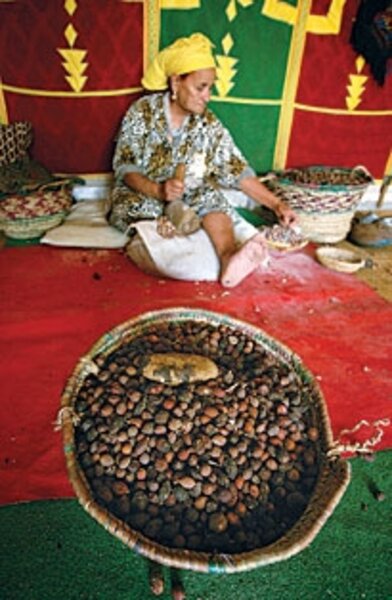Morocco: Demands rise on argan tree
Loading...
• A local, slice-of-life story from a Monitor correspondent.
ESSAOUIRA, MOROCCO – For centuries, the Berber people of south-west Morocco have used oil from a tree endemic to the region as a staple food and in traditional medicines.
In recent years, there’s been increasing demand for oil from the argan tree in Western countries, where it’s used by gourmet chefs, and by cosmetic companies which claim it has antiaging and restorative properties. Now the Moroccan government is hoping to triple production of argan oil by 2020, from the current level of around 100 tons a year.
It’s hoped that poor rural women in particular would benefit from expansion of the argan oil industry in an arid region with few industries and employment prospects. The trouble is, the slow-growing argan tree is already listed as an endangered species, presenting scientists with a huge challenge to avert over-exploitation.
Argan oil comes from the two to three kernels found inside the pit of the oval-shaped green fruit of the tree. Traditionally, it is women who crack the pit, lightly roast the kernels, then pound and knead the resulting paste to extract the oil.
Using traditional methods, 2 pints of oil requires about 220 lbs. of fruit, and up to about 20 hours of work in one of about 25 women’s cooperatives set up in the region since 1996. Some of the co-ops have introduced a degree of mechanization that reduces the amount of manual labor required.
Others, however, such as the Marjana Cooperative near the Atlantic coastal city of Essaouira, prefer to maintain traditional methods to maximize employment. As the Marjana Co-op’s production rose from 1.5 tons in 2006 to 3.4 tons last year, the number of women employed full time almost doubled to nearly 50 workers.
For many women, it is their first paid job, and they can earn up to about $280 a month – a good sum in a region where many people live below the poverty line.
The Marjana Co-op, which was set up by a parents’ organization so that the women could work while their children are at school, also provides basic literacy and numeracy classes between shifts to those who need it.
“It is important that those of us who have had a good education help the other women in this way,” says sales assistant Ghizlane Zakkar, who studied for four years for a law degree, but can’t find work as a lawyer. Raising literacy levels is also seen as an important part of spreading the message among the Berber women about preserving argan trees for future generations, Ms. Zakkar says.
In 1998, UNESCO declared almost 10,000 square miles of southwest Morocco, including the whole argan-growing region, to be a special “biosphere reserve.”
Besides the argan tree’s various human uses, UNESCO noted, it also acted as a buffer against northern expansion of the Sahara Desert – a role that remains just as critical today.





